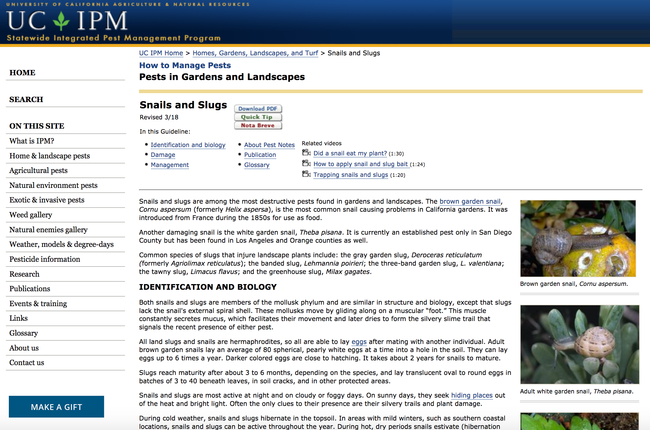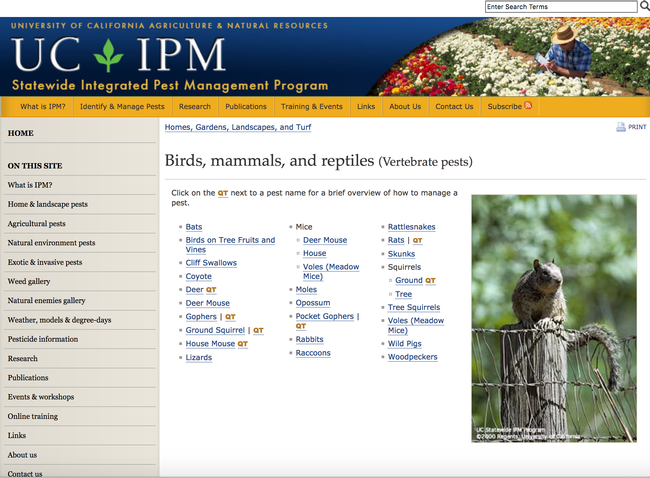By Iris Craig, U. C. Master Gardener of Napa County
When I asked a friend how her garden was doing, she told me that the day after she planted lettuce and basil, she found nothing but stumps. I told her that the likely culprits were snails, birds or rodents. Her response: “Okay, but what can I do about it?”
Some say that a French chef introduced brown snails to California during the Gold Rush. They may be tasty with garlic butter, but they are destructive garden pests. What's more, they're prolific. These hermaphrodites lay, on average, 80 eggs every six months. They move on their foot, munching on plants during the night and foggy days. When the sun is out they hide in debris or tight leaves. They leave irregular holes with smooth edges and silvery mucous trails on seedlings, leaves and flowers.
The least toxic way to vanquish snails is to hunt them at night with a flashlight. If you pluck them off plants every other night for six weeks, you can win the battle. I collect them in a lidded jar or can and bring them to friends with chickens. Snail favorites include basil, beans, cabbage, dahlias, delphinium, hosta, lettuce, marigolds and strawberries, so monitor those plants closely.
You can trap snails by burying a shallow tin can or jar lid at ground level and filling it with beer. The snails are attracted to the beer and drown. You can also trap them by laying down boards with a stone at one end as a riser. The snails will crawl underneath. Copper barriers can help as snails don't like to crawl over them, but the copper deteriorates and needs replacing often. I have also had some success with string that emits a small charge. Egg shells and coffee grounds placed around plants can deter snails, especially in conjunction with other pest-management practices.
Before buying snail bait, do some research. Some formulations kill good creatures as well as snails and are potentially dangerous to small animals and plants. Iron phosphate baits such as Sluggo and Slug Magic are safer around children and small animals and can reduce snail populations.
Pesky birds in the Napa Valley include crowned sparrows, house finches, robins, scrub jay, crows, European starlings and yellow-billed magpies. They love ripe blueberries, tomatoes, grapes, strawberries, cherries and many other fruits. They also shred the edges of tender green leaves such as lettuce. Netting is the best deterrent. Drape the top of the tree or plant and secure the edges at ground level to prevent entry. Other methods include noisemakers, visual repellents, shooting, trapping and chemical repellents. All of these options help, but some may harm other animals.
Common rodents in the Napa Valley include roof rats, Norway rats, tree squirrels, ground squirrels, mice and bats. Roof rats and Norway rats are among the most troublesome garden pests in the United States. To control them, you need to know which species you are dealing with.
Sometimes called brown rats or sewer rats, Norway rats are stocky and larger than roof rats. They leave droppings and paper nests and they burrow under buildings and wood piles and in moist areas. Roof rats are climbers and nest in trees, tall shrubs and dense vegetation like ivy. You may also find them in attics and walls. Roof rats have a long tail, longer than their head and body combined. Unlike the Norway rat, they prefer an ocean climate and have a narrower range of habitat.
When you hear scurrying noises at night, grab a flashlight. Young roof rats can be mistaken for mice; however, their heads are larger in proportion to their bodies. Once you see evidence of rats outdoors, prepare to do battle or they will soon invade your home.
The easiest way to foil rats is to call an exterminator. Seal any openings in your home that are larger than one-quarter inch. Remove debris and place wire-mesh barricades around your garden if you have a large infestation. As a last resort, set spring traps. If necessary, use a poison that won't harm pets or children. Place it near pathways or wherever you see droppings.
My friend who asked me what was eating her plants saw a squirrel chomping on one. She now has a cage around her garden.
Workshop: Master Food Preservers will hold a workshop on “Food Preservation by Freezing & Drying” on Friday, July 27, from 10 a.m. to noon, at University of California Cooperative Extension, 1710 Soscol Avenue, Napa. Canning, freezing and drying are among the most basic food preserving methods. It is important to practice safe methods and to stay up-to-date with the most reliable information about food safety. Master Food Preservers will discuss each process, the equipment required and hazards to avoid, and give demonstrations and recipes. Online registration (credit card only); Mail-in/Walk-in registration (check only or drop off cash payment).
Workshop: Master Food Preservers will hold a workshop on “Pickling and Fermenting” on Saturday, July 28, from 10 a.m. to noon, at University of California Cooperative Extension, 1710 Soscol Avenue, Napa. Pickles are anything preserved by acidity. Vegetables that are fermented in the home kitchen create their own self-preserving, acidic liquid that is a by-product of the fermentation process. Led by Master Food Preservers, we will learn the basics of pickling and fermenting, understand the cautions involved in home food preservation, watch a demonstration of each process, and discuss recipes easily managed by the home cook.Online registration (credit card only); Mail-in/Walk-in registration (check only or drop off cash payment).
Master Gardeners are volunteers who help the University of California reach the gardening public with home gardening information. U. C. Master Gardeners of Napa County ( http://ucanr.edu/ucmgnapa/) are available to answer gardening questions in person or by phone, Monday, Wednesday and Friday, 9 a.m. to Noon, at the U. C. Cooperative Extension office, 1710 Soscol Avenue, Suite 4, Napa, 707-253-4143, or from outside City of Napa toll-free at 877-279-3065. Or e-mail your garden questions by following the guidelines on our web site. Click on Napa, then on Have Garden Questions? Find us on Facebook under UC Master Gardeners of Napa County.
Attached Images:

UC IPM Pest Note on Snails and Slugs. http://ipm.ucanr.edu/PMG/PESTNOTES/pn7427.html

UC IPM on Vertebrate Pests. If the following link does not take you to the UC IPM page, copy and paste it in your browser. Or just type UC IPM VERTEBRATE PESTS and you'll get there. http://ipm.ucanr.edu/PMG/menu.vertebrate.html